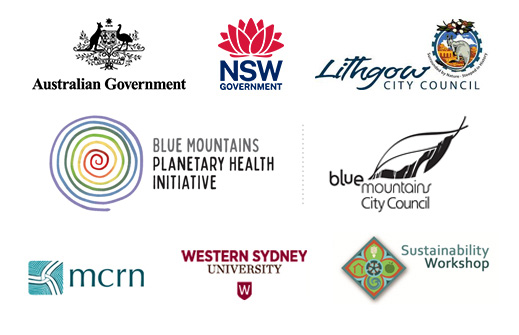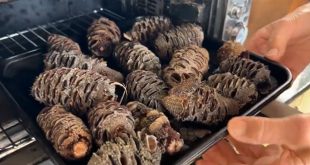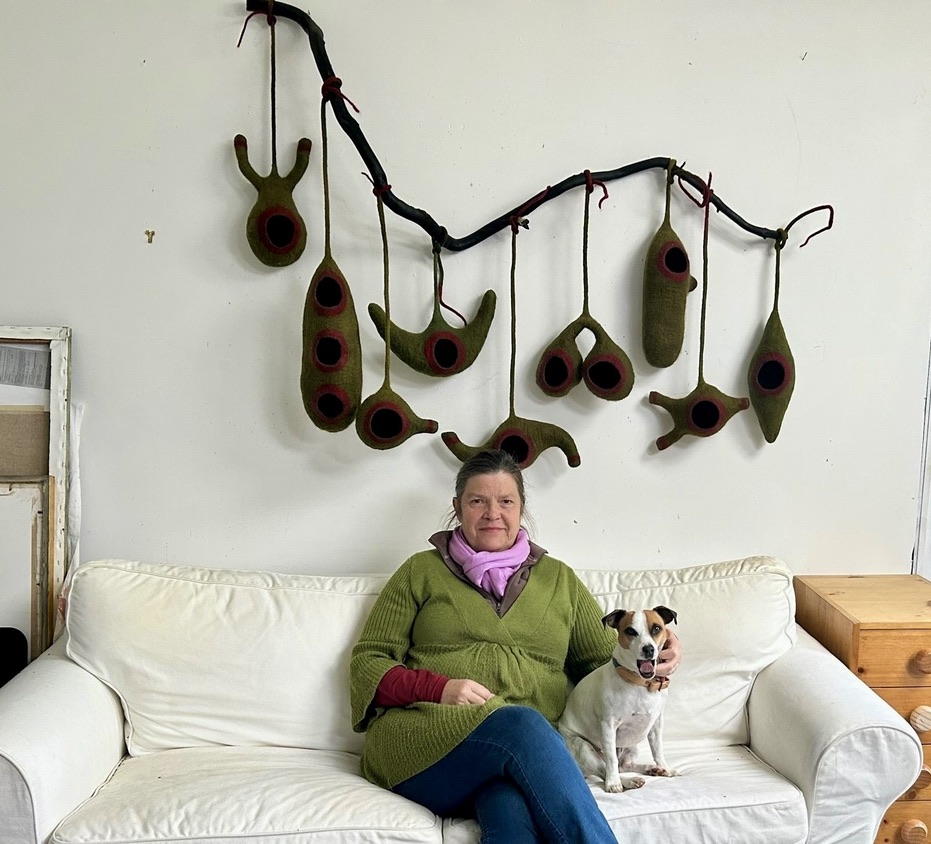
Saskia and her dog Tucker with artwork Refuge in her studio (Liz Durnan)
By Liz Durnan
Katoomba artist Saskia Everingham reveals the inspiration behind three artworks and how art helps anchor her in an uncertain world.
Around the time bushfires raged towards Saskia Everingham’s South Katoomba home in 2019, she was ready to give up on being an artist.
Saskia had begun to feel that it was thankless work with little recognition, even less pay and a heap of rejection. But after the trauma of bushfire, she turned to art to anchor herself and find a way to address the unmooring she had felt afterwards.
“I’m always looking at what’s happening, looking at the sky and seeing what’s going on in my environment. There were flocks of birds around calling out because everything’s burnt, they had no food, no water, no shelter, nothing.
“I’ve got an affinity for a whole family of yellow-tailed black cockatoos in the trees at the back of my house, so it was very distressing. But it wasn’t just them; it was all the birds.”
Saskia was evacuated from her home overnight, but it was enough to give her a taste of displacement.
“It was long enough to make you think, ‘What the f**k?’ And this is may be only a billionth of what it must be like for actual refugees and all the people and animals that don’t have places to live.”
At around the same time, Saskia’s adult son couldn’t find anywhere to live in Sydney with nowhere available he could afford. This fed into Saskia’s sense of loss and displacement.
“It was all compounding and undermining that sense of solidity you get from having a home base, in nature as well as in our economy.
“It’s a very light way of touching the ground – not bricks and mortar – everything’s mobile and changing and it’s like a murmuration of birds, just shifting and moving around.”
But for Saskia, who loves the solidity of a home base, it brought on “a bit of a dark night of the soul.”
Then she saw a post on Facebook calling for entries to an art prize at Eden Gardens. The criteria ticked all the boxes of what interests her about the environment and sustainability. “I thought I’d just give it a shot,” she says.
From this, her prize winning artwork ‘Refuge’ was born.
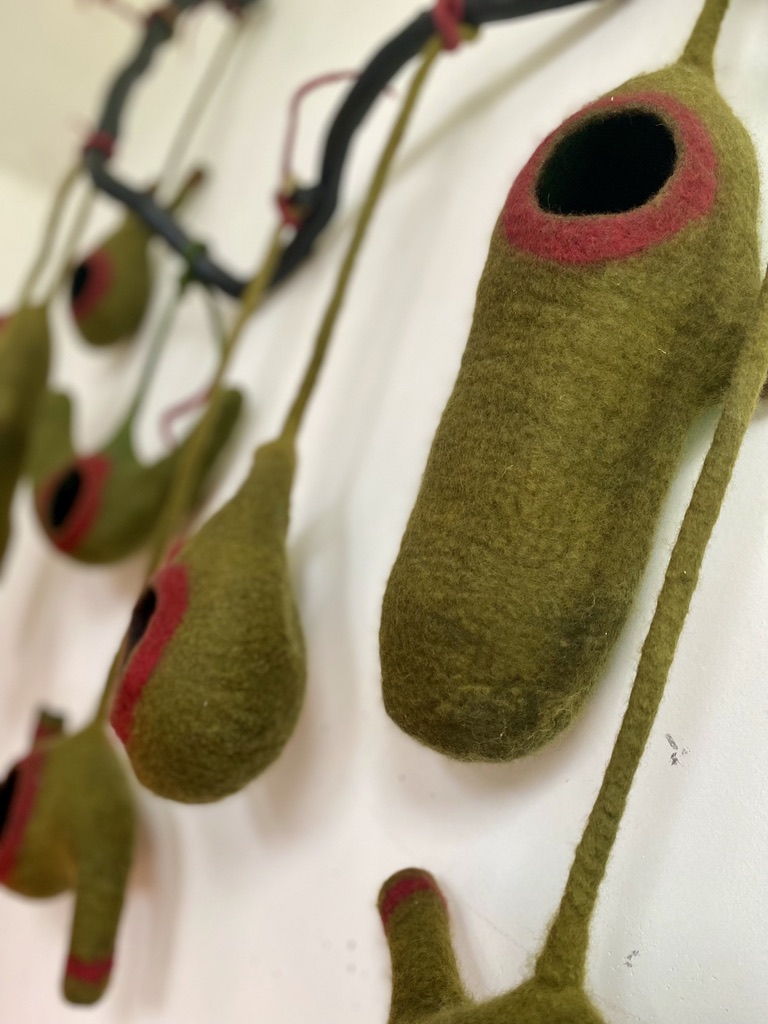
Close-up of Refuge (supplied)
Saskia looked at the site first – “a spectacularly beautiful garden” – and chose a little gum tree for the location of Refuge because it was most similar to the trees in her Mountain environment. She constructed little pods from wool felt and hung them on long strings to resemble nests, choosing colours to match the gum trees, the red flecks almost camouflaging the pods in the tree.
In contrast, perhaps for something more grounding and permanent, the round shape was inspired by old European churches: “Strangely, I was also thinking of Romanesque churches, which are big and solid. They’ve got four-foot walls and big round shapes; they were like battlements effectively, just very protective.”
But there’s an impermanence too that reflects how Saskia thinks housing may need to be in the future:
“You can untie them and tie them up and they’re all different because we’re going to need all kinds of permutations of homing and housing, different ways of living.
“This is my way of saying it’s not an ideal solution, but a potential solution might be to be adaptable and flexible about the way we live in the future.”
Creating these nests was Saskia’s way of imagining, through art, how we might cope in the future with climate induced disasters. She’s inspired to find solutions and positive stories “rather than bang on about how terrible things are.”
Saskia took the same approach to another site-specific work, also for a competition – the North Sydney Art Prize. It was held at the Coal Loader Centre for Sustainability, a hectare-sized ex-industrial harbourside site where the trains used to dump coal to be loaded onto ships. It’s now dedicated to sustainable research and features gardens, art, heritage tours and events.
“I really enjoy responding to a particular site, finding out about the history and picking up the vibe of the place.” She selected a site near the long wharf, half a kilometre of collapsed gnarled grey wood stretching out into the bay, “a metaphor for the collapse of the whole industry and now going back to its roots.”
The work itself, entitled Phoenix Trees, comprised a row of 59 pots of native trees of varying shapes and sizes – one pot representing every year of Saskia’s life up to that point.
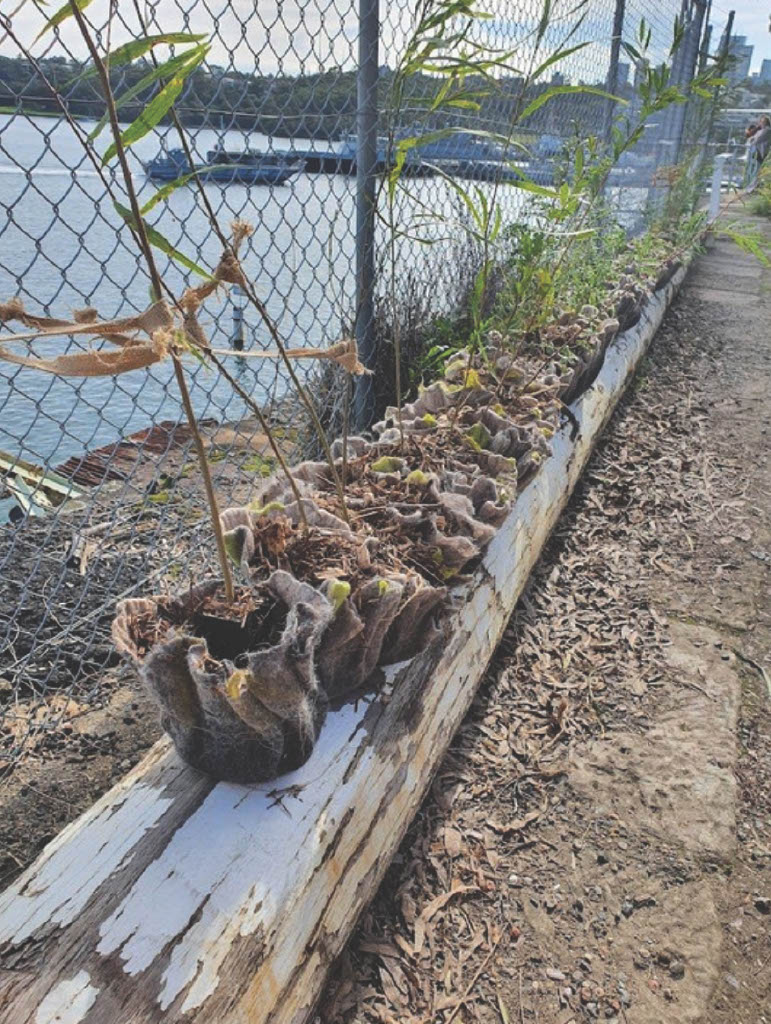
Phoenix Trees at the site of the Coal Loader Centre for Sustainability (supplied)
Each pot symbolised giving back for one of those years, an idea sparked by a ton of coal kept in a perspex box at the site. She was told that even if you planted a tree for every day of your life, you could still not replace the amount of energy you would have used. Saskia was determined to replace at least some of what she’d used.
With Saskia’s home in Katoomba, right next door to the Blue Mountains Wild Plant Rescue nursery, she acquired all 59 native trees there and created the pots herself with felt made in regional NSW. The felt is biodegradable so after the exhibition, the potted plants could be planted straight into the ground, the felt even helping to hold moisture.
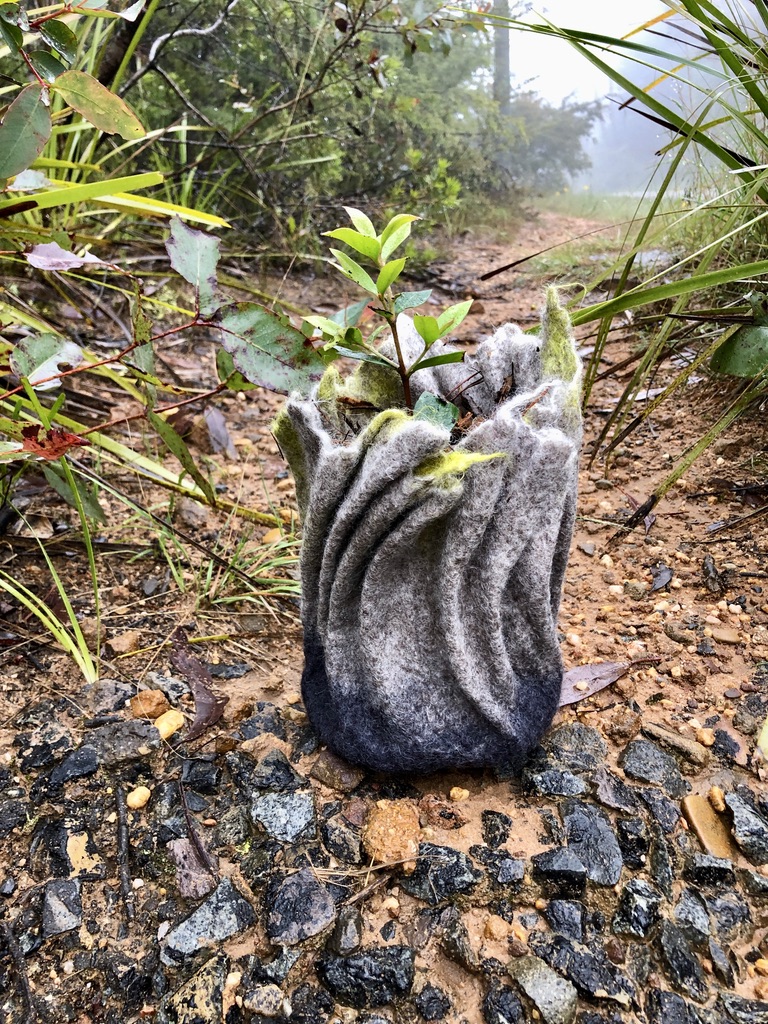
Individual felt pots
“We have to be mindful of what we do with the art when we’re finished, so rather than just dumping them I wanted to plant them somewhere useful. Lis [Bastian] suggested planting them at Headspace in Katoomba and that made perfect sense to me, as there were young people building a permaculture garden there.
Photo: Phoenix Trees won the Site-Specific Award at the North Sydney Art Prize (supplied)
It’s a heartening and hopeful story and this is what Saskia aims for in her artworks: “I don’t want to tell stories of doom and gloom of which there have been so many; people switch off and it just adds to the load of anxiety that we all have.
“There’s a lot of people doing a lot of really fantastic stuff. It’s a symbolic thing – I can’t fix that stuff, but at least I can make a gesture towards it, and who knows if that has some Butterfly Effect somewhere.”
Certainly, the judges responded to the work and Saskia took the Site-Specific Award. Winning prizes since the bushfires has given Saskia “a huge amount of confidence” and reinvigorated her as an artist. In fact, for many years she called herself a craftsperson, reluctant to carry the mantle of artist.
“Craftspeople make beautiful stuff but it doesn’t always have meaning behind it. Art is not just the beautiful physical object, but the thought behind it can bring a useful message as well.”
Another of Saskia’s more recent artworks was inspired by the bushfires of 2019/2020.
“Two and a half billion bees died in New South Wales alone,” says Saskia, referring to how the loss of trees meant the loss of their hollows. “And bees are crucial to our survival by making everything grow.”
Saskia’s artwork ‘Honey Homes’ is focused on the bees themselves, not just their use to humans. This stunning artwork is based on a photo Saskia saw of a beehive that wasn’t man-made, but created free-form by the bees.
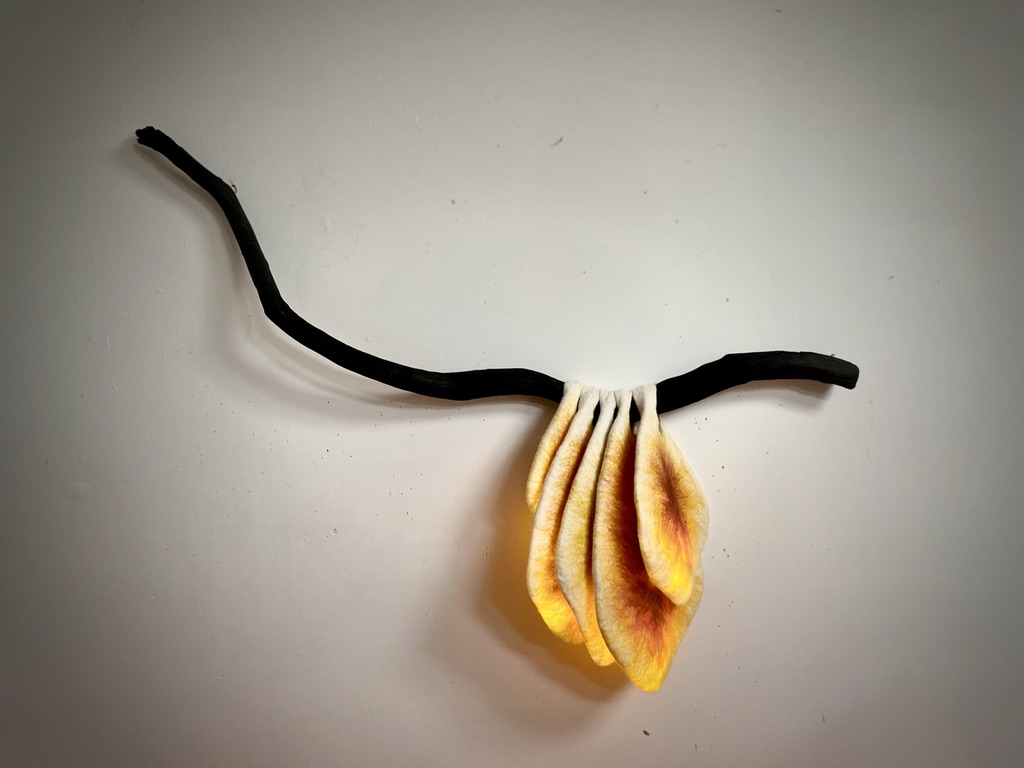
Honey Homes (supplied)
“It just grew naturally in the tree and it was this beautiful, curvy, sensuous, full of delicious, nutritious honey. And I thought, ‘My god, that’s such an image of abundance and warmth and all the good stuff.’
“If we were to take humans out of the equation, if we start to consider that bees are not there just to serve us, but if bees are allowed to be there because they’re fabulous, these are the kind of shapes that they would make in their natural habitat.
“They’re allowed to expand and grow. They can choose their own queens and they can create their own size of colonies. I love honey, but there’s a lot of corralling of bees’ natural proclivity in the making of honey for us.”
As with Refuge, Honey Homes is about loss of habitat. “It’s about making a symbolic home for them because each pouch is like a little habitat.”
This reflects Saskia’s approach to art, its symbolism her way of offering hope when feeling disempowered.
“It’s like you’re working up in Plato’s ideal forms. I don’t know if it percolates down or you’re stealing something that’s in the zeitgeist in some way, which is possibly one of the reasons why people responded to it.”
Saskia also hopes that by focusing on animals she can appeal to people’s emotions. “I’m consciously trying to focus on how these climatic issues are impacting the animals because people are sometimes more open to animals being in trouble than humans.
“I’m aiming to engage people emotionally rather than intellectually, because intellectually we all know what’s happening, but that doesn’t always spur us to action. And we’re not a culture that is greatly attuned to listening to things with our hearts.”
Perhaps people are craving this emotional depth, she thinks, because the art world has tended to focus on the intellectually clever or witty, not the emotional.
“As you can tell, I’m quite an emotional person,” she says with feeling. “That’s a part of us that’s undervalued and underrepresented.
“So as an older woman, and a mum, I can probably bring some of that experience into my art. And I think there’s a bit of a gap there.”
To find out more about Saskia Everingham: https://www.saskiaeveringham.com/
This story has been produced as part of a Bioregional Collaboration for Planetary Health and is supported by the Disaster Risk Reduction Fund (DRRF). The DRRF is jointly funded by the Australian and New South Wales governments.
